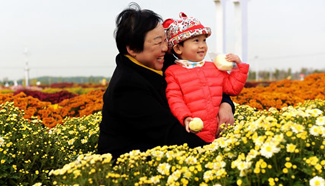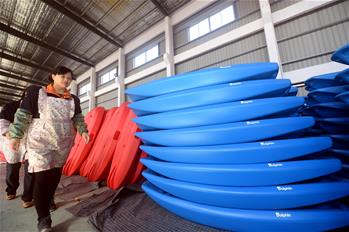JINAN, Nov. 4 (Xinhua) -- Flood. House. Flood. For the past decades, Liu Yongcai, a lifelong resident on the banks of the Yellow River, has been fighting floods and building houses.
Liu, 68, lives in Changxingji Township, Dongming county in Heze City, one of the least developed cities in eastern China.
The slow and silty-brown waters of the Yellow River run eastwards near his home. The river, dubbed the Mother River of China, has long nurtured lands for farmers like Liu, but it has brought floods that swallowed their homes.
Liu's hometown is located in the floodplain area between the main channel and high levees. In Heze, more than 400,000 people live in the floodplain of the Yellow River.
During Liu's lifetime, floods have hit his home 14 times, with the ones in 1996, 1998 and 2003 being the largest. "When the flood came, I left to hide, and when I came back, the houses were damaged and needed repair or rebuilding," he said.
Liu has built six houses in his life after previous ones were left dilapidated by floodwater. "Building new houses has become the purpose of my life. I've had enough of it. I'd rather be drowned and hit dead by bricks than build another one," he said.
New houses on the floodplain area are more costly because they need to be elevated from the ground. "Such a foundation for a single home costs 60,000 to 80,000 yuan (89,000 to 118,700 U.S. dollars), about the same amount of money needed to build a house," Liu said. "Every time I build a house, I spend up all my money and have to borrow. When the debt clears, the floods come again."
Home-building has become the fundamental cause of poverty for people on the floodplains, said Cai Weichao, head of the poverty-relief office in Heze City. More than 168,000 people, or 42 percent of residents, live below the poverty line, making 2,800 yuan (418 U.S. dollars) or less every year.
POVERTY ALONG THE MOTHER RIVER
According to State Council figures, close to 1.9 million people live on the floodplain of the Yellow River. Poverty is hard to beat in these settlements.
No factories or companies are allowed near the banks, and the only residents are farmers who make a living growing maize and corn.
"In some areas, the poverty rate is more than 50 percent of the population," said Wang Haifeng, chief of poverty relief in Dongming County.
"No woman wants to come and marry a man from here. You would not believe it. A groom would have to offer thousands of yuan to the bride's family. And in order to get a wife, you would get poor again," said Yang Guojing, a farmer in Changxinji.
Every spring, the Xiaolangdi Reservoir, located upstream in Henan Province, discharges huge amounts of water in order to quickly move the silt downstream. Farmers who live close to the river bank have to watch out for overflowing water.
Having a stronger and better house is the dream of many residents along the riverbank, Wang said.
TWO ALTERNATIVES
Since a massive flood in 1996, the provincial government of Shandong organized two massive evictions of residents from the riverbank. Over 20,000 people, including households in Changxingji Township, were told to leave.
After the evictions, farmers had to live in smaller houses at least a dozen kilometers away from their hometowns, sharing land with farmers from other villages. The new settlements are also densely populated.
Several hundred people settled in new homes, but some of them had difficulties adjusting to the new environment and chose to come back, Wang said.
Though still weary of floods as global warming continues, they want to hold onto the land where they grow up, and are unwilling to leave.
"So we are offering two options now. Leave, or build safer and stronger homes which can stand a massive flood," Wang said, adding that the latter option is favored by many.
In Changxinji Township, the government has secured funding from the Asian Development Bank and state urbanization loans, to build large cement foundations on which farmers can build new houses. Two elevated structures in the town are over 600,000 square meters. They are flood proofed, at least four meters high, and designed to accommodate thousands of new houses.
Either way, safe housing is a massive and expensive project for people living on the floodplain.
Twenty more such foundations need to be built in Dongming county, and total costs could exceed 6 billion yuan, according to estimates. Relocation packages are also costly, and 1,200 hectares of land needs to be emptied to accommodate the displaced farmers.
"We are in urgent need of more funds to expedite our way out of poverty," Wang said.
Meanwhile, Liu Yongcai is building a new house on a flood-proof foundation, which he vows will be his last.
"This house, I hope it can stand for 100 years," he said.










